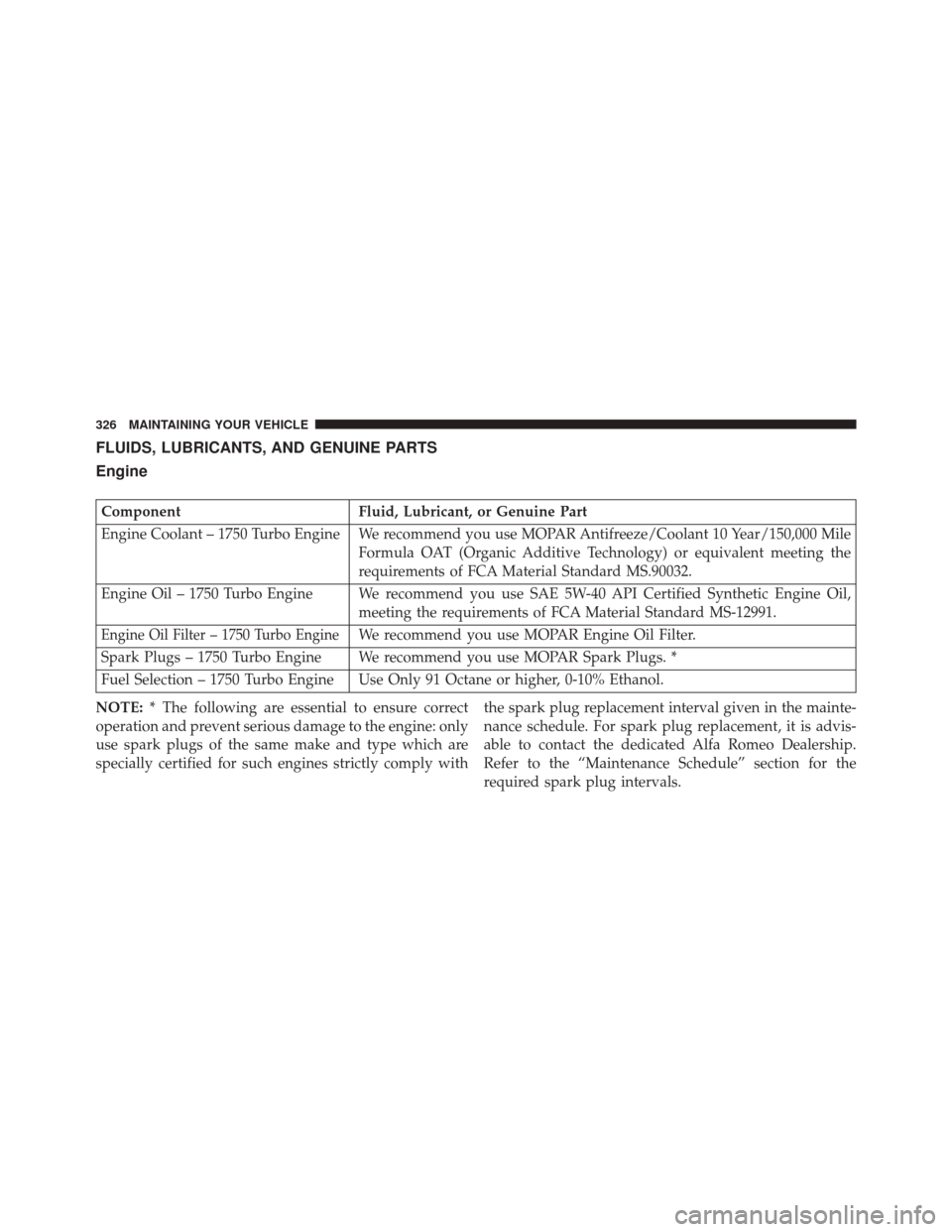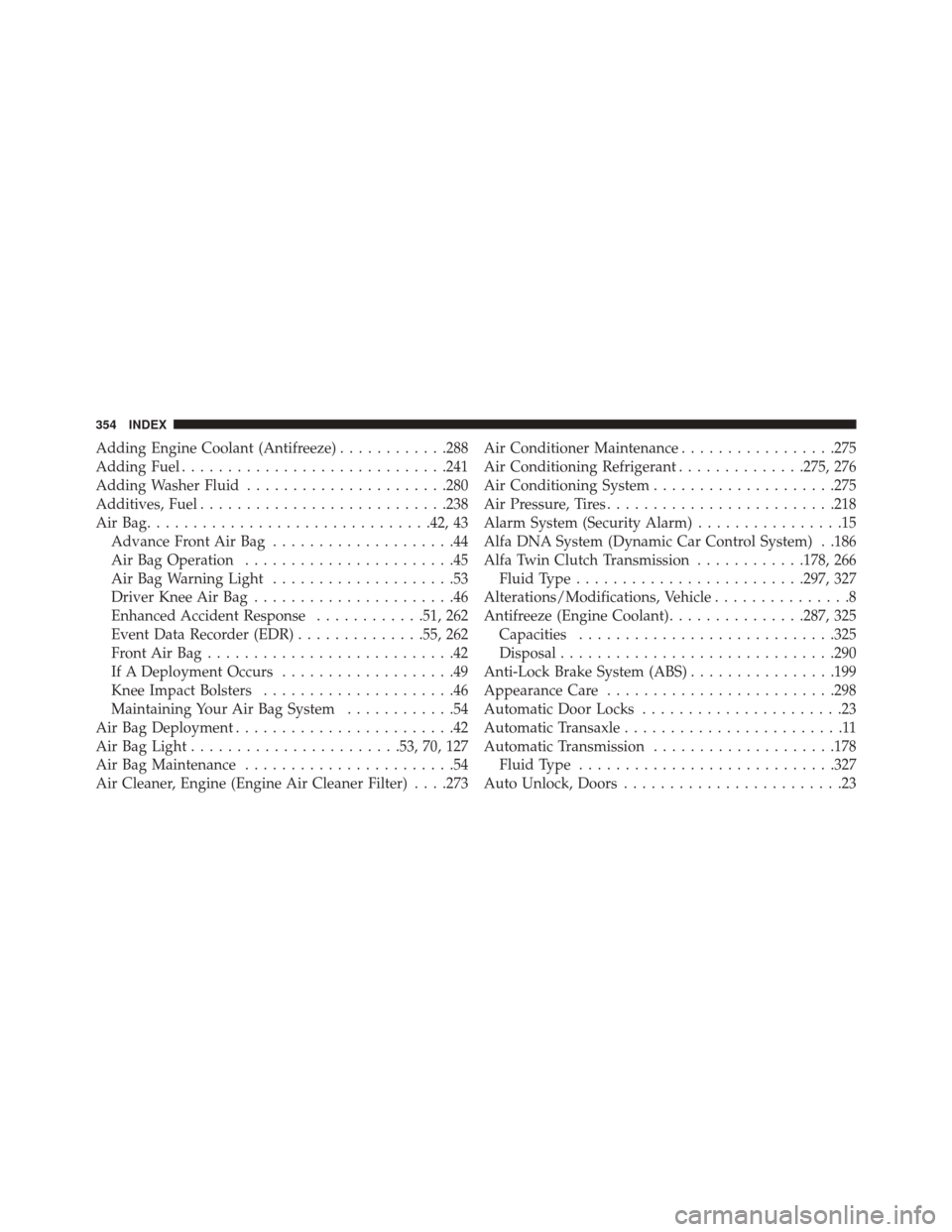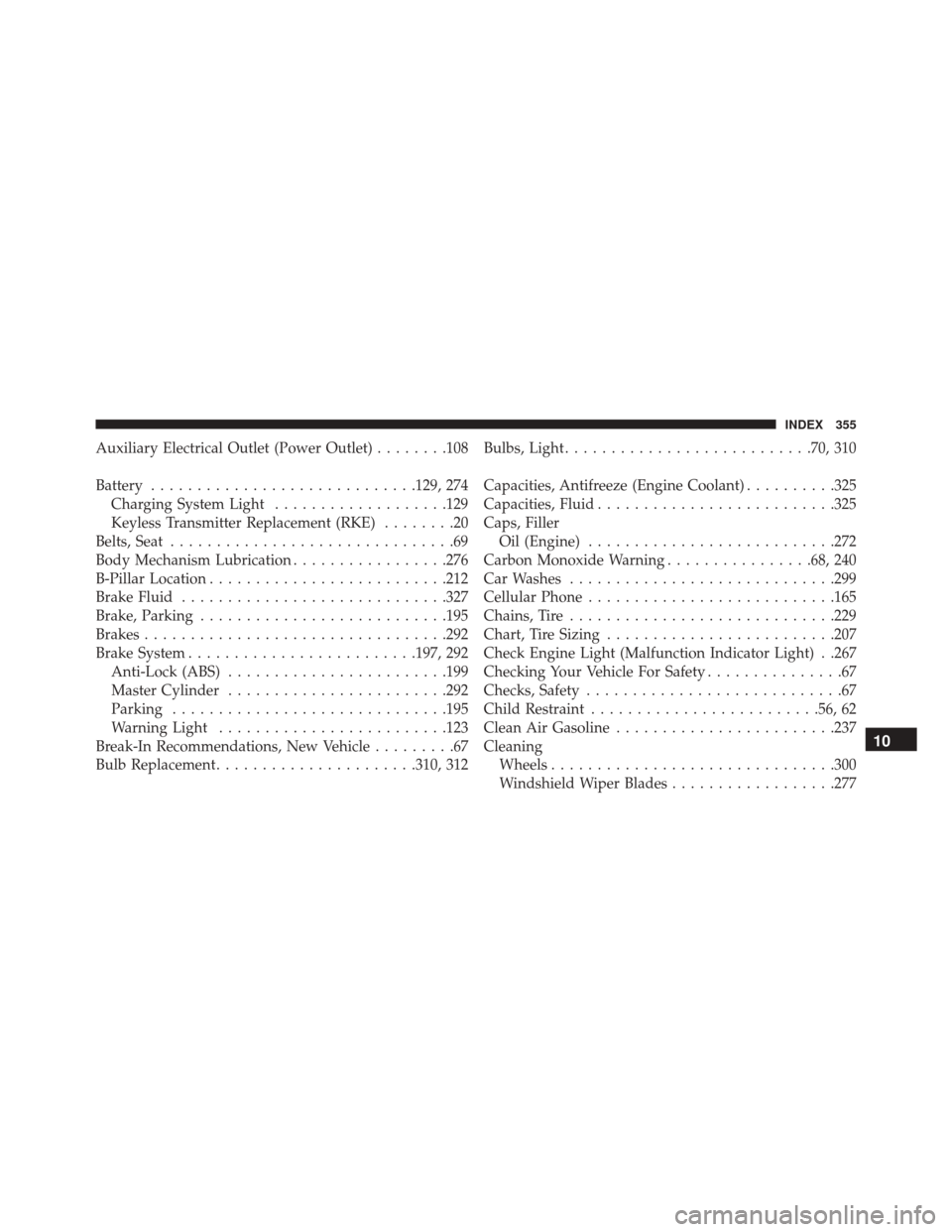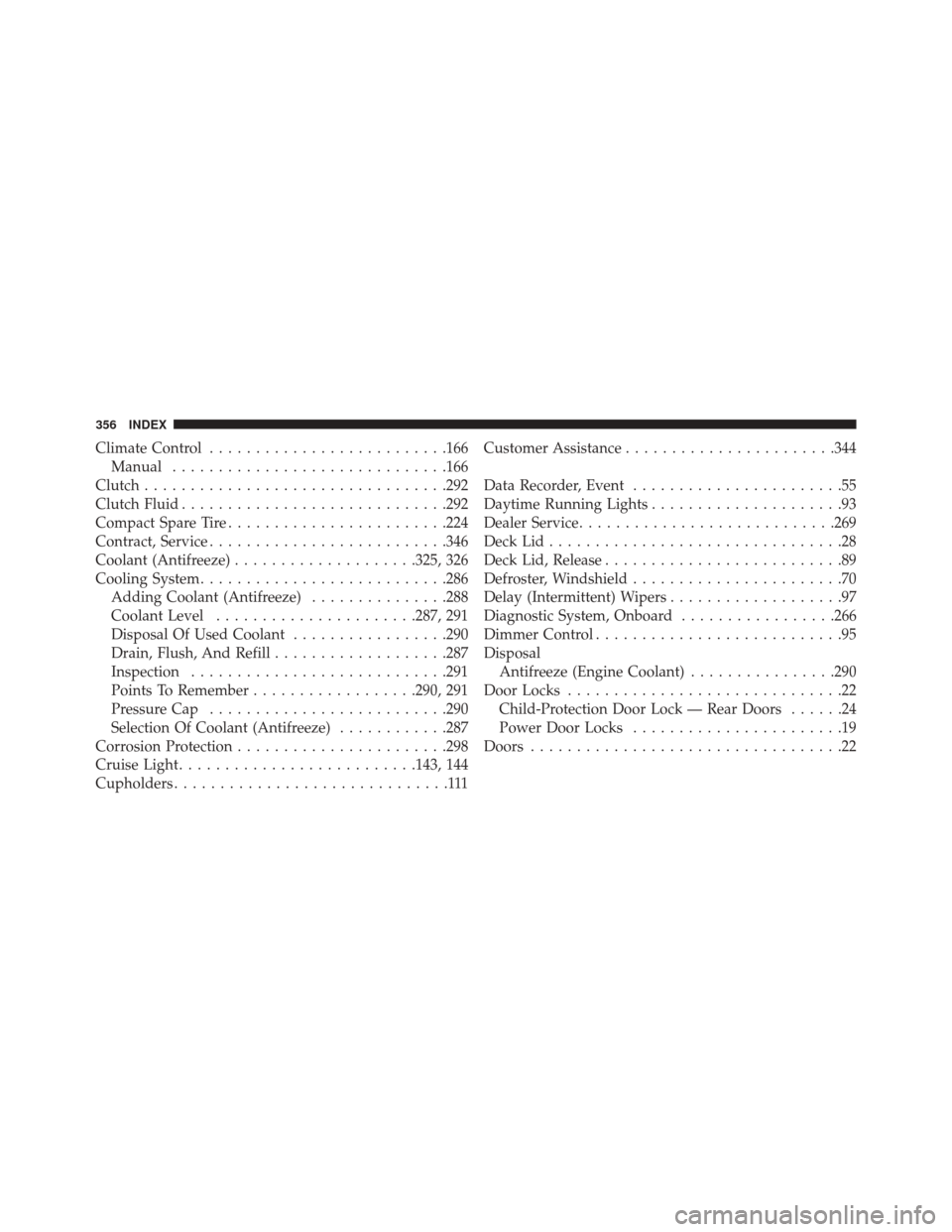engine coolant Alfa Romeo 4C Spider 2016 User Guide
[x] Cancel search | Manufacturer: ALFA ROMEO, Model Year: 2016, Model line: 4C Spider, Model: Alfa Romeo 4C Spider 2016Pages: 371, PDF Size: 2.93 MB
Page 292 of 371

Cooling System Pressure Cap
The cap must be fully tightened to prevent loss of engine
coolant (antifreeze) and to ensure that engine coolant
(antifreeze) will return to the radiator from the coolant
recovery tank.
The cap should be inspected and cleaned if there is any
accumulation of foreign material on the sealing surfaces.
WARNING!
•Do not open hot engine cooling system. Never add
engine coolant (antifreeze) when the engine is
overheated. Do not loosen or remove the cap to cool
an overheated engine. Heat causes pressure to
build up in the cooling system. To prevent scalding
or injury, do not remove the pressure cap while the
system is hot or under pressure.
(Continued)
WARNING! (Continued)
•Do not use a pressure cap other than the one
specified for your vehicle. Personal injury or en-
gine damage may result.
Disposal Of Used Engine Coolant
Used ethylene glycol-based engine coolant (antifreeze) is
a regulated substance requiring proper disposal. Check
with your local authorities to determine the disposal
rules for your community. To prevent ingestion by ani-
mals or children, do not store ethylene glycol-based
engine coolant in open containers or allow it to remain in
puddles on the ground. If ingested by a child or pet, seek
emergency assistance immediately. Clean up any ground
spills immediately.
290 MAINTAINING YOUR VEHICLE
Page 293 of 371

Coolant Level
The coolant expansion bottle provides a quick visual
method for determining that the coolant level is ad-
equate. With the engine off and cold, the level of the
engine coolant (antifreeze) in the bottle should be be-
tween the “MIN” and “MAX” marks.
As long as the engine operating temperature is satisfac-
tory, the coolant bottle need only be checked once a
month.
When additional engine coolant (antifreeze) is needed to
maintain the proper level, it should be added to the
coolant bottle. Do not overfill.
Points To Remember
NOTE:When the vehicle is stopped after a few miles/
kilometers of operation, you may observe vapor coming
from the front of the engine compartment. This is nor-
mally a result of moisture from rain, snow, or high
humidity accumulating on the radiator and being vapor-
ized when the thermostat opens, allowing hot engine
coolant (antifreeze) to enter the radiator.
If an examination of your engine compartment shows no
evidence of radiator or hose leaks, the vehicle may be
safely driven. The vapor will soon dissipate.
• Do not overfill the coolant expansion bottle.
• Check the coolant freeze point in the radiator and in
the coolant expansion bottle. If engine coolant (anti-
freeze) needs to be added, the contents of the coolant
expansion bottle must also be protected against freez-
ing.
7
MAINTAINING YOUR VEHICLE 291
Page 294 of 371

•If frequent engine coolant (antifreeze) additions are
required, the cooling system should be pressure tested
for leaks.
• Maintain engine coolant (antifreeze) concentration at a
minimum of 50% OAT coolant (conforming to
MS.90032) and distilled water for proper corrosion
protection of your engine which contains aluminum
components.
• Keep the front of the radiator clean. If your vehicle is
equipped with air conditioning, keep the front of the
condenser clean.
• Do not change the thermostat for Summer or Winter
operation. If replacement is ever necessary, install
ONLY the correct type thermostat. Other designs may
result in unsatisfactory engine coolant (antifreeze)
performance, poor gas mileage, and increased emis-
sions.Brake System
In order to assure brake system performance, all brake
system components should be inspected periodically.
Refer to the “Maintenance Schedule” for the proper
maintenance intervals.
WARNING!
Riding the brakes can lead to brake failure and
possibly a collision. Driving with your foot resting or
riding on the brake pedal can result in abnormally
high brake temperatures, excessive lining wear, and
possible brake damage. Riding the brakes may also
reduce braking capacity in an emergency.
Brake Master Cylinder
The fluid level in the master cylinder should be checked
when performing under hood services, or immediately if
the “Brake Warning Light” is on.
292 MAINTAINING YOUR VEHICLE
Page 327 of 371

FLUID CAPACITIES
U.S.Metric
Fuel (Approximate)
1750 Turbo Engine 10.5 Gallons40 Liters
Reserve Fuel 1.1 Gallons4 Liters
Engine Oil with Filter
1750 Turbo Engine 6.1 Quarts5.8 Liters
Cooling System
1750 Turbo Engine (MOPAR
Antifreeze/Engine Coolant 10
Year/150,000 Mile Formula). 11.2 Quarts
10.6 Liters
7
MAINTAINING YOUR VEHICLE 325
Page 328 of 371

FLUIDS, LUBRICANTS, AND GENUINE PARTS
Engine
ComponentFluid, Lubricant, or Genuine Part
Engine Coolant – 1750 Turbo Engine We recommend you use MOPAR Antifreeze/Coolant 10 Year/150,000 Mile Formula OAT (Organic Additive Technology) or equivalent meeting the
requirements of FCA Material Standard MS.90032.
Engine Oil – 1750 Turbo Engine We recommend you use SAE 5W-40 API Certified Synthetic Engine Oil, meeting the requirements of FCA Material Standard MS-12991.
Engine Oil Filter – 1750 Turbo EngineWe recommend you use MOPAR Engine Oil Filter.
Spark Plugs – 1750 Turbo Engine We recommend you use MOPAR Spark Plugs. *
Fuel Selection – 1750 Turbo Engine Use Only 91 Octane or higher, 0-10% Ethanol.
NOTE: * The following are essential to ensure correct
operation and prevent serious damage to the engine: only
use spark plugs of the same make and type which are
specially certified for such engines strictly comply with the spark plug replacement interval given in the mainte-
nance schedule. For spark plug replacement, it is advis-
able to contact the dedicated Alfa Romeo Dealership.
Refer to the “Maintenance Schedule” section for the
required spark plug intervals.
326 MAINTAINING YOUR VEHICLE
Page 334 of 371

If the vehicle is operated in a dusty or dirty environment
the engine air filter has to be changed every 6,500 miles
(10,000 km).
Once A Month Or Before A Long Trip/Periodic Checks
Every 600 miles (1,000 km) or before long trips, check
and, if necessary, top off the following:
•Check engine oil level
• Check brake fluid level
• Check windshield washer fluid level
• Check the tire inflation pressures and look for unusual
wear or damage •
Check the fluid levels of the coolant reservoir and
brake master cylinder reservoir, and add as needed
• Check function of all interior and exterior lights
• Check screen wash/wipe system and positioning/
wear of windscreen
Every 2,000 miles (3,000 km) check and, if necessary, top
up: engine oil level
332 MAINTENANCE SCHEDULES
Page 340 of 371

Mileage or time passed
(whichever comes first)
12,000
24,000
36,000
48,000
60,000
72,000
84,000
96,000
108,000
120,000
132,000
144,000
156,000
Or Months: 12 24 36 48 60 72 84 96 108 120 132 144 156
Or Kilometers:
20,000
40,000
60,000
80,000
100,000
120,000
140,000
160,000
180,000
200,000
220,000
240,000
260,000
Check condition and wear
of rear brake pads and
discs, and operation of
pad wear indicator XXXXXXXXXXXXX
Check and top off, if re-
quired, fluid levels (engine
coolant, brake/hydraulic
clutch fluid, windscreen
washer fluid, battery fluid,
etc) XXXXXXXXXXXXX
Visually inspect the condi-
tion of accessory drive
belt(s) XX X X
338 MAINTENANCE SCHEDULES
Page 356 of 371

Adding Engine Coolant (Antifreeze)............288
Adding Fuel ............................ .241
Adding Washer Fluid ..................... .280
Additives, Fuel .......................... .238
AirBag.............................. .42, 43
Advance Front Air Bag ....................44
Air Bag Operation .......................45
Air Bag Warning Light ....................53
Driver Knee Air Bag ......................46
Enhanced Accident Response ............51, 262
Event Data Recorder (EDR) ..............55, 262
FrontAirBag...........................42
If A Deployment Occurs ...................49
Knee Impact Bolsters .....................46
Maintaining Your Air Bag System ............54
Air Bag Deployment ........................42
Air Bag Light ...................... .53, 70, 127
Air Bag Maintenance .......................54
Air Cleaner, Engine (Engine Air Cleaner Filter) . . . .273 Air Conditioner Maintenance
.................275
Air Conditioning Refrigerant ..............275, 276
Air Conditioning System ....................275
Air Pressure, Tires ........................ .218
Alarm System (Security Alarm) ................15
Alfa DNA System (Dynamic Car Control System) . .186
Alfa Twin Clutch Transmission ............178, 266
Fluid Type ........................ .297, 327
Alterations/Modifications, Vehicle ...............8
Antifreeze (Engine Coolant) ...............287, 325
Capacities ........................... .325
Disposal ............................. .290
Anti-Lock Brake System (ABS) ................199
Appearance Care ........................ .298
Automatic Door Locks ......................23
Automatic Transaxle ........................11
Automatic Transmission ....................178
Fluid Type ........................... .327
Auto Unlock, Doors ........................23
354 INDEX
Page 357 of 371

Auxiliary Electrical Outlet (Power Outlet)........108
Battery ............................ .129, 274
Charging System Light ...................129
Keyless Transmitter Replacement (RKE) ........20
Belts, Seat ...............................69
Body Mechanism Lubrication .................276
B-Pillar Location ......................... .212
Brake Fluid ............................ .327
Brake, Parking .......................... .195
Brakes ................................ .292
Brake System ........................ .197, 292
Anti-Lock (ABS) ....................... .199
Master Cylinder ....................... .292
Parking ............................. .195
Warning Light ........................ .123
Break-In Recommendations, New Vehicle .........67
Bulb Replacement ..................... .310, 312Bulbs, Light
.......................... .70, 310
Capacities, Antifreeze (Engine Coolant) ..........325
Capacities, Fluid ......................... .325
Caps, Filler Oil (Engine) .......................... .272
Carbon Monoxide Warning ................68, 240
Car Washes ............................ .299
Cellular Phone .......................... .165
Chains, Tire ............................ .229
Chart, Tire Sizing ........................ .207
Check Engine Light (Malfunction Indicator Light) . .267
Checking Your Vehicle For Safety ...............67
Checks, Safety ............................67
Child Restraint ........................ .56, 62
Clean Air Gasoline ....................... .237
Cleaning Wheels .............................. .300
Windshield Wiper Blades ..................277
10
INDEX 355
Page 358 of 371

Climate Control......................... .166
Manual ............................. .166
Clutch ................................ .292
Clutch Fluid ............................ .292
Compact Spare Tire ....................... .224
Contract, Service ......................... .346
Coolant (Antifreeze) ....................325, 326
Cooling System .......................... .286
Adding Coolant (Antifreeze) ...............288
Coolant Level ..................... .287, 291
Disposal Of Used Coolant .................290
Drain, Flush, And Refill ...................287
Inspection ........................... .291
Points To Remember ..................290, 291
Pressure Cap ......................... .290
Selection Of Coolant (Antifreeze) ............287
Corrosion Protection ...................... .298
Cruise Light ......................... .143, 144
Cupholders ..............................111 Customer Assistance
...................... .344
Data Recorder, Event .......................55
Daytime Running Lights .....................93
Dealer Service ........................... .269
Deck Lid ................................28
Deck Lid, Release ..........................89
Defroster, Windshield .......................70
Delay (Intermittent) Wipers ...................97
Diagnostic System, Onboard .................266
Dimmer Control ...........................95
Disposal Antifreeze (Engine Coolant) ................290
Door Locks ..............................22
Child-Protection Door Lock — Rear Doors ......24
Power Door Locks .......................19
Doors ..................................22
356 INDEX